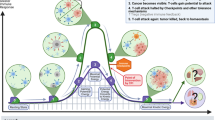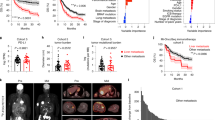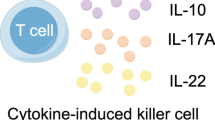Abstract
Surgery represents the only chance of cure for patients with colorectal liver metastases. The results of expanded indications for surgical treatment revealed that even advanced disease can be cured in a significant percentage of cases. What is the explanation for this systemic impact of a local treatment such as surgery? What is different in those patients who can be cured by resection? In this review we analyse the available evidence of the complex relationship between the growing tumour and the immune system. Special attention is directed to the role of T regulatory cells (Tregs) recruited by the tumour to construct a tolerogenic microenvironment in which to grow. Based on the published data we developed the hypothesis that surgery breaks the tumour immune tolerance status because it not only removes the tumour, but also the protective shield of T regulatory cells.
Similar content being viewed by others
References
Wagner J, Adson M, Van Heerden J et al (1984) The natural history of hepatic metastases from colorectal cancer. A comparison with resective treatment. Ann Surg 199:502–504
Weber J, Bachelier P, Oussoultzoglou E et al (2003) Simultaneous resection of colorectal primary and synchronous liver metastases. Br J Surg 90:956–962
Figueras J, Valls C, Rafecas A et al (2001) Resection rate and effect of postoperative chemotherapy on survival after surgery for colorectal liver metastases. Br J Surg 88:980–985
Poston G, Adam R, Alberts S et al (2005) Oncosurge: a strategy for improving resectability with curative intent in mestastatic colorectal cancer. J Clin Oncol 23:7125–7134
Figueras J, Torras J, Valls C et al (2007) Surgical resection of colorectal liver metastases in patients with expanded indications. A single-center experience with 501 patients. Dis Colon Rectum 50:478–488
Bismuth E, Adam R, Levi F et al (1996) Resection of nonresectable liver metastases from colorectal cancer after neoadjuvant chemotherapy. Ann Surg 224:509–520
Adam R, Delvart V, Pascal G et al (2004) Rescue surgery for unresectable colorectal liver metastases downstaged by chemotherapy. A model to predict longterm survival. Ann Surg 240:644–657
Campi G, Crosti M, Consogno G et al (2003) CD4+ T cells from healthy subjects and colon cancer patients recognize a carcinoembryonic antigen-specific immunodominant epitope. Cancer Res 63:8481–8486
Schmitt E, Parcellier A, Ghiringhelli F et al (2004) Increased immunogenicity of colon cancer cells by selective depletion of cytochrome C. Cancer Res 64:2705–2711
Banerjea A, Bustin S, Dorudi S (2005) The immunogenicity of colorectal cancer with high-degree microsatellite instability. World J Surg Oncol 3:26
Shunyakov L, Ryan C, Sahasrabude D et al (2004) The influence of host response in colorectal cancer prognosis. Clin Colorectal Cancer 4:38–45
Jass J, Love S, Northover J (1987) A new prognostic classification of rectal cancer. Lancet 1:1303–1306
Naito Y, Saito K, Shiba K et al (1998) CD8+ T cells infiltrated within cancer cell nests as a prognostic factor in human colorectal cancer. Cancer Res 58:3491–3494
Evans C, Dalgleish A, Kumar D (2006) Immune suppression and colorectal cancer. Aliment Pharmacol Ther 8:1163–1177
Hensler T, Hecker H, Heeg K et al (1997) Distinct mechanisms of immunosuppression as a consequence of major surgery. Infect Immun 65:2283–2291
Stalder M, Birsan T, Hausen B et al (2005) Immunosuppressive effects of surgery assessed by flow cytometry in nonhuman primates after nephrectomy. Transpl Intern 18:1158–1165
Weighardt H, Heidecke C, Emmanuilidis K et al (2000) Sepsis after major visceral surgery is associated with sustained and interferon-gamma-resistant defects of monocyte cytokine production. Surgery 127:309–315
Heidecke C, Weighardt H, Hensler T et al (2000) Immune paralysis of T-lymphocytes and monocytes in postoperative abdominal sepsis. Correlation of immune function with survival. Chirurg 71:159–165
O’sullivan S, Lederer J, Horgan A et al (1995) Major injury leads to predominance of the T helper-2 lymphocyte phenotype and diminished interleukin-12 production associated with decreased resistance to infection. Ann Surg 222:482–490
Spolarics Z, Siddiqi M, Siegel J et al (2003) Depressed interleukin-12-producing activity by monocytes correlates with adverse clinical course and a shift toward Th2-type lymphocyte pattern in severely injured male trauma patients. Crit Care Med 31:1722–1729
Lyons A, Kelly J, Rodrick M et al (1997) Major injury induces increased production of interleukin-10 by cells of the immune system with a negative impact on resistance to infection. Ann Surg 226:450–458; discussion 458–460
Lyons A, Goebel A, Mannick J et al (1999) Protective effects of early interleukin-10 antagonism on injury-induced immune dysfunction. Arch Surg 134:1317–1323, discussion 1324
Kelly JL, Lyons A, Soberg C et al (1997) Anti-interleukin-10 antibody restores burn-induced defects in T cell function. Surgery 122:146–152
Kawaida H, Kono K, Takahashi A et al (2005) Distribution of CD4+CD25+high regulatory T cells in tumor-draining lymph nodes in patients with gastric cancer. J Surg Res 124:151–157
Zou W (2006) Regulatory T cells, tumour immunity and immunotherapy. Nat Rev Immunol 6:295–307
Shimizu J, Yamazaki S, Sakaguchi S (1999) Induction of tumor immunity by removing CD25+CD4+ T cells: a common basis between tumor immunity and autoimmunity. J Immunol 163:5211–5218
Casares N, Arribillaga L, Sarobe P et al (2003) CD4+/CD25+ regulatory cells inhibit activation of tumour-primed CD4+ T cells with IFN-gamma-dependent antiangiogenic activity, as well as long-lasting tumour immunity elicited by peptide vaccination. J Immunol 171:5931–5939
Woo E, Chu Ch, Goletz T et al (2001) Regulatory CD4+CD25+ T cells in tumors from patients with early-stage non-small cell lung cancer and late stage ovarian cancer. Cancer Res 61:4766–4772
Okita R, Saeki T, Takashima S et al (2005) CD4+CD25+ regulatory T cells in the peripheral blood of patients with breast cancer and non-small cell lung cancer. Oncol Rep 14:1269–1273
Ko K, Yamazaki S, Nakamura K et al (2005) Treatment of advanced tumors with agonistic anti-GITR mAb and its effects on tumor-infiltrating FoxP3CD25+CD4+ regulatory T cells. J Exp Med 202:885–891
Curiel T, Coukos G, Zou L et al (2004) Specific recruitment of regulatory T cells in ovarian carcinoma fosters immune privilege and predicts reduced survival. Nat Med 10:942–949
Kobayashi N, Hiraoka N, Yamagami W et al (2007) FOXP+regulatory T cells affect the development and progression of hepatocarcinogenesis. Clin Cancer Res 13:902–911
Yang X, Yamagiwa S, Ichida T et al (2006) Increase of CD4+CD25+ regulatory T cells in the liver of patients with hepatocellular carcinoma. J Hepatol 45:254–262
Unitt E, Rushbrook S, Marshall A et al (2005) Compromised lymphocytes infiltrate hepatocellular carcinoma: the role of T-regulatory cells. Hepatology 41:722–730
Shevach E (2004) Fatal attraction: tumors beckon regulatory T cells. Nat Med 10:900–901
Liyanage U, Goedegebuure P, Moore T et al (2006) Increased prevalence of regulatory T cells (Tregs) is induced by pancreas adenocarcinoma. J Immunother 29:416–424
von Boehmer H (2003) Dynamics of suppressor T cells: in vivo veritas. J Exp Med 198:845–849
Kilinc M, Aulakh K, Nair R et al (2006) Reversing tumor immune suppression with intratumoral IL-12: activation of tumor-associated T effector/memory cells, induction of T suppressor apoptosis, and infiltration of CD+ T effectors. J Immunol 177:6962–6973
Correale P, Cusi M, Tsang K et al (2005) Chemo-immunotherapy of metastatic colorectal carcinoma with Gemcitabine plus FOLFOX 4 followed by subcutaneous granulocyte macrophage colony-stimulating factor and interleukin-2, induces strong immunologic and antitumor activity in metastatic colon cancer patients. J Clin Oncol 23:8950–8958
Jewell A (2005) Is the liver an important site for the development of immune tolerance to tumours? Med Hypotheses 64:751–754
Bowen D, Zen M, Holz L et al (2004) The site of primary T cell activation is a determinant of the balance between intrahepatic tolerance and immunity. J Clin Invest 114:701–712
Bowen D, McCaughan G, Bertolino P (2005) Intrahepatic immunity: a tale of two sites? Trends Immunol 26:512–517
Bertolino P, McCaughan G, Bowen D (2002) Role of primary intrahepatic T cell activation in the “liver tolerance effect”. Immunol Cell Biol 80:84–92
Yoshimura N, Matsui S, Hamashima T et al (1990) The effects of perioperative portal venous inoculation with donor lymphocytes on renal allograft survival in the rat. Specific prolongation of donor grafts and suppressor factor in the serum. Transplantation 49:167–171
Katz S, Pillarisetty V, Bleier J et al (2004) Liver sinusoidal endothelial cells are insufficient to activate T cells. J Immunol 173:230–235
Sasada T, Kimura M, Yoshida Y et al (2003) CD4+CD25+ regulatory T cells in patients with gastrointestinal malignancies: possible involvement of regulatory T cells in disease progression. Cancer 98:1089–1099
Ichihara F, Kono K, Takahashi A et al (2003) Increased populations of regulatory T cells in peripheral blood and tumor-infiltrating lymphocytes in patients with gastric and esophageal cancers. Clin Cancer Res 9:4404–4408
Author information
Authors and Affiliations
Corresponding author
Rights and permissions
About this article
Cite this article
González, H.D., Figueras, J. Effect of surgical resection of metastatic disease on immune tolerance to cancer. How a systemic disease could be controlled by a local therapy. Clin Transl Oncol 9, 571–577 (2007). https://doi.org/10.1007/s12094-007-0105-5
Received:
Accepted:
Published:
Issue Date:
DOI: https://doi.org/10.1007/s12094-007-0105-5




